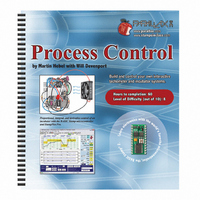122-28176 Parallax Inc, 122-28176 Datasheet - Page 314

122-28176
Manufacturer Part Number
122-28176
Description
GUIDE STUDENT PROCESS CONTROL
Manufacturer
Parallax Inc
Specifications of 122-28176
Accessory Type
Manual
Product
Microcontroller Accessories
Lead Free Status / RoHS Status
Contains lead / RoHS non-compliant
For Use With/related Products
Propeller Education (PE) Kit
Lead Free Status / RoHS Status
Lead free / RoHS Compliant, Contains lead / RoHS non-compliant
- Current page: 314 of 330
- Download datasheet (11Mb)
Page 304 · Process Control
Derivative control acts by taking action based on a change of error, often from one
reading to the next. It evaluates the slope of the changing output and acts in opposition to
the change. Derivative control can prevent hunting and oscillations, but too much drive
can send a system into wild oscillations.
Each control mode has its own unique characteristic response to maintaining the desired
output. Volumes have been written on the subject of PID control and tuning. Not all
systems require all three evaluations and drive. The floating ball, discussed earlier,
operates fine without integral, but derivative is a must because of the fast disturbance
reaction needed. A car's cruise control doesn't need derivative, because in general fast
disturbances are unlikely and the control action would be probably be uncomfortable to
feel.
We have just scratched the surface of process control theory through feedback. Our focus
has been limited to control action based on feeding back information from the output of
our process. When disturbances affect our process, changes in the output are detected and
generate an error signal. PID is tuned to drive the error away as quickly as possible. Tight
control of the process variable is possible with PID, but the fundamental premise of
feedback control is to respond to error. Error is expected and, to a certain degree,
tolerated.
As we leave this chapter, consider an alternative to feedback control. That is feed-
forward control. In feed-forward control you measure those factors that disturb a process.
Understanding how they affect the variable you are holding constant will allow for output
action to be taken before an error signal results. If you could measure changes in ambient
temperature and wind speed from the fan, could you use this information to better control
your incubator?
Related parts for 122-28176
Image
Part Number
Description
Manufacturer
Datasheet
Request
R

Part Number:
Description:
MANUAL FOR SUMOBOT
Manufacturer:
Parallax Inc
Datasheet:

Part Number:
Description:
GUIDE STUDENT SMART SENSORS
Manufacturer:
Parallax Inc
Datasheet:

Part Number:
Description:
MANUAL PROPELLER
Manufacturer:
Parallax Inc
Datasheet:

Part Number:
Description:
LEAD WIRES FLYING CABLE III/IV
Manufacturer:
Xilinx Inc
Datasheet:

Part Number:
Description:
BOARD ADAPTER AND FLY LEADS
Manufacturer:
Xilinx Inc
Datasheet:

Part Number:
Description:
PLATFORM CABLE USB II
Manufacturer:
Xilinx Inc
Datasheet:

Part Number:
Description:
KIT STARTER COOLRUNNER-II BUNDLE
Manufacturer:
Xilinx Inc
Datasheet:

Part Number:
Description:
Microcontroller Modules & Accessories DISCONTINUED BY PARALLAX
Manufacturer:
Parallax Inc

Part Number:
Description:
Microcontroller Modules & Accessories DISCONTINUED BY PARALLAX
Manufacturer:
Parallax Inc

Part Number:
Description:
BOOK UNDERSTANDING SIGNALS
Manufacturer:
Parallax Inc
Datasheet:

Part Number:
Description:
BOARD EXPERIMENT+LCD NX-1000
Manufacturer:
Parallax Inc
Datasheet:

Part Number:
Description:
IC MCU 2K FLASH 50MHZ SO-18
Manufacturer:
Parallax Inc
Datasheet:












